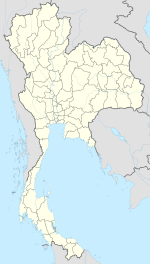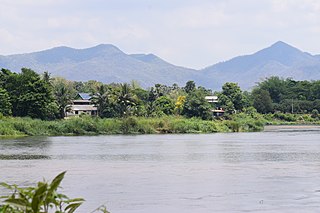
Tak is one of Thailand's seventy-seven provinces (changwat) and lies in lower northern Thailand. Neighbouring provinces are Mae Hong Son, Chiang Mai, Lamphun, Lampang, Sukhothai, Kamphaeng Phet, Nakhon Sawan, Uthai Thani and Kanchanaburi. The western edge of the province has a long boundary with Kayin State of Myanmar (Burma).
Thai Airways Company or Thai Airways was the domestic flag carrier of Thailand. Its main base was the domestic terminal at Don Mueang International Airport. Its head office was located in Pom Prap Sattru Phai, Bangkok. In 1988 Thai Airways merged to become Thai Airways International.

The Thahan Phran AKA the Royal Thai Paramilitary Force is a paramilitary light infantry force which patrols the borders of Thailand and is an auxiliary of the Royal Thai Army (RTA) and the Royal Thai Marine Corps (RTMC). The Thahan Phran operate in conjunction with the Border Patrol Police (BPP), but are trained and equipped to engage in combat while the BPP is primarily a law enforcement agency. In Thailand there is a common name of black clothing unit (นักรบเสื้อดำ) or the Black Army due to their wearing of black uniforms.

The Kayan are a sub-group of Red Karen, Tibeto-Burman ethnic minority of Myanmar (Burma). The Kayan consists of the following groups: Kayan Lahwi, Kayan Ka Khaung (Gekho), Kayan Lahta, Kayan Ka Ngan. Kayan Gebar, Kayan Kakhi and, sometimes, Bwe people (Kayaw). They are distinct from, and not to be confused with, the Kayan people of Borneo.
After the 1978 Vietnamese invasion of Cambodia and subsequent collapse of Democratic Kampuchea in 1979, the Khmer Rouge fled to the border regions of Thailand, and, with assistance from China, Pol Pot's troops managed to regroup and reorganize in forested and mountainous zones on the Thai-Cambodian border. During the 1980s and early 1990s Khmer Rouge forces operated from inside refugee camps in Thailand, in an attempt to de-stabilize the pro-Hanoi People's Republic of Kampuchea's government, which Thailand refused to recognise. Thailand and Vietnam faced off across the Thai-Cambodian border with frequent Vietnamese incursions and shellings into Thai territory throughout the 1980s in pursuit of Cambodian guerrillas who kept attacking Vietnamese occupation forces.

Extremely Severe Cyclonic Storm Nargis was an extremely destructive and deadly tropical cyclone that caused the worst natural disaster in the recorded history of Myanmar during early May 2008. The cyclone made landfall in Myanmar on Friday, 2 May 2008, sending a storm surge 40 kilometres up the densely populated Irrawaddy delta, causing catastrophic destruction and at least 138,373 fatalities. The Labutta Township alone was reported to have 80,000 dead, with about 10,000 more deaths in Bogale. There were around 55,000 people missing and many other deaths were found in other towns and areas, although the Myanmar government's official death toll may have been under-reported, and there have been allegations that government officials stopped updating the death toll after 138,000 to minimise political fallout. The feared 'second wave' of fatalities from disease and lack of relief efforts never materialised. Damage was at $12 billion, making Nargis the costliest tropical cyclone on record in the North Indian Ocean at the time, before that record was broken by Cyclone Amphan in 2020.
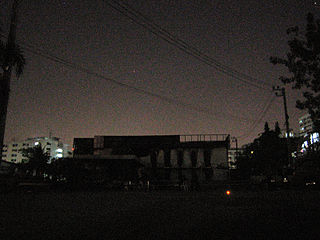
The Santika Club fire occurred on Thursday 1 January 2009, in the Santika Club nightclub in Ekkamai, Watthana, Bangkok, Thailand, where New Year celebrations were taking place. A total of 66 people were killed and another 222 injured when fire swept through the nightclub during the New Year's celebration as a band, coincidentally called "Burn", was playing. By another coincidence, the party was named "Santika's Last Night". The fire broke out at 00:35. and citizens of thirteen countries were among the injured.

The 2010 Thai political protests were a series of political protests that were organised by the United Front for Democracy Against Dictatorship (UDD) in Bangkok, Thailand from 12 March–19 May 2010 against the Democrat Party-led government. The UDD called for Prime Minister Abhisit Vejjajiva to dissolve parliament and hold elections earlier than the end of term elections scheduled in 2012. The UDD demanded that the government stand down, but negotiations to set an election date failed. The protests escalated into prolonged violent confrontations between the protesters and the military, and attempts to negotiate a ceasefire failed. More than 80 civilians and six soldiers were killed, and more than 2,100 injured by the time the military violently put down the protest on 19 May.
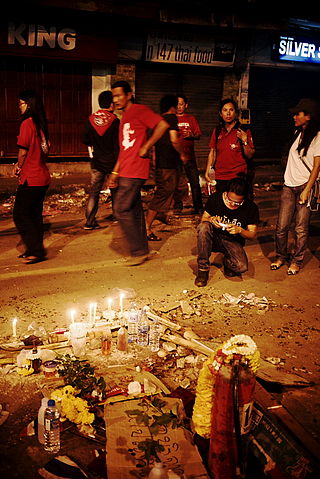
On 10 April and 13–19 May 2010, the Thai military cracked down on the United Front for Democracy Against Dictatorship (UDD) protests in central Bangkok, the capital of Thailand. The crackdown was the culmination of months of protests that called for the Democrat Party-led government of Abhisit Vejjajiva to dissolve parliament and hold elections. The crackdowns occurred in the vicinity of protest sites near Phan Fa Lilat Bridge and Ratchaprasong intersection. More than 85 were killed, including more than 80 civilians according to the Erawan EMS Center. Two foreigners and two paramedics were killed. More than 2,000 were injured, an undisclosed number of arrests occurred, and 51 protesters remained missing as of 8 June. The Thai media dubbed the crackdowns "Cruel April" and "Savage May". After the protest, its leaders surrendered at the conclusion of the 19 May crackdown, followed by dozens of arson attacks nationwide, including at CentralWorld. Two red shirts who were accused of arson were acquitted later in both courts.
The 2010–2012 Myanmar border clashes were a series of skirmishes between the Tatmadaw on one side, and the DKBA-5 and the Karen National Liberation Army (KNLA) on the other. The clashes erupted along the border with Thailand shortly after Myanmar's general election on 7 November 2010. An estimated 10,000 refugees have fled into nearby neighbouring Thailand to escape the violent conflict. There was concern that due to discontent with the elections, and speculations of electoral fraud, that the conflict could escalate into a civil war.
A Mw 6.8 earthquake occurred on 24 March 2011 in Shan State, Myanmar. It had an epicenter northwest of the border between Myanmar, Thailand and Laos. The earthquake killed between 75 and 151 people; including one fatality in Thailand. Hundreds of buildings were damaged in Myanmar and Thailand. An additional 212 people were injured.

Mae La, Beh klaw ,(S'gaw Karen: မဲၣ်လးဒဲကဝီၤ, ဘဲကျီး) is a refugee camp in Thailand. It was established in 1984 in Tha Song Yang District, Tak Province in the Dawna Range area and houses 50,000 Karen refugees; the number continues to rise as of June 2019. Mae La is the largest refugee camp for Karen refugees in Thailand. Over 90% are the persecuted ethnic Karen. The camps are overseen and run by the Thailand Burma Border Consortium (TBBC), a union of 11 international non-governmental organizations that provide food, shelter and non food items to the Burmese refugees and displaced people.

Extremely Severe Cyclonic Storm Forrest, also referred to as Tropical Storm Forrest while in the western Pacific basin before its Thai crossover, was a powerful tropical cyclone that prompted the evacuation of 600,000 people in Bangladesh in late November 1992. Originating from an area of disturbed weather near the Caroline Islands on November 9, Forrest was classified as a tropical depression three days later over the South China Sea. Tracking generally west, the system steadily organized into a tropical storm, passing Vietnam to the south, before striking Thailand along the Malay Peninsula on November 15. Once over the Bay of Bengal, Forrest turned northward on November 17 and significantly intensified. It reached its peak intensity on November 20 as a Category 4-equivalent cyclone on the Saffir–Simpson hurricane scale with winds of 230 km/h (140 mph). Hostile environmental conditions soon affected the cyclone as it turned abruptly east-northeastward. Forrest made landfall in northwestern Myanmar as a weakening system on November 21 before dissipating early the next day.
The year 2013 was the 232nd year of the Rattanakosin Kingdom of Thailand. It was the 68th year in the reign of King Bhumibol Adulyadej, and is reckoned as year 2556 in the Buddhist Era. The year saw the beginning of protests against Prime Minister Yingluck Shinawatra's government which led to a state of political crisis and the dissolution of government.
The year 2017 is the 236th year of the Rattanakosin Kingdom of Thailand. It is the 2nd year in the reign of King Vajiralongkorn, and is reckoned as year 2560 in the Buddhist Era.
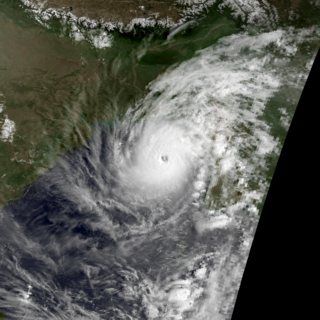
The 1994 Bangladesh cyclone was a powerful tropical cyclone in the Bay of Bengal. The cyclone closely followed the path, strength, and time of year of a deadly cyclone in 1991 that killed more than 138,000 people. The 1994 cyclone formed on April 29 as a depression, which organized and intensified significantly over the subsequent few days. On May 2, the cyclone attained winds of 215 km/h (135 mph), according to the India Meteorological Department (IMD). That day, the storm made landfall in southeastern Bangladesh, and rapidly weakened over land, before dissipating on May 3.

On 22 March 2021, a fire that had started during the late afternoon in the Balukhali refugee camp in Cox's Bazar, Bangladesh, destroyed a large portion of the camp, killed over a dozen people, and left nearly a thousand injured or missing. Thought to have begun when gas cylinders used for cooking exploded, 100 firemen fought the blaze, which burned for around eight hours until midnight.
